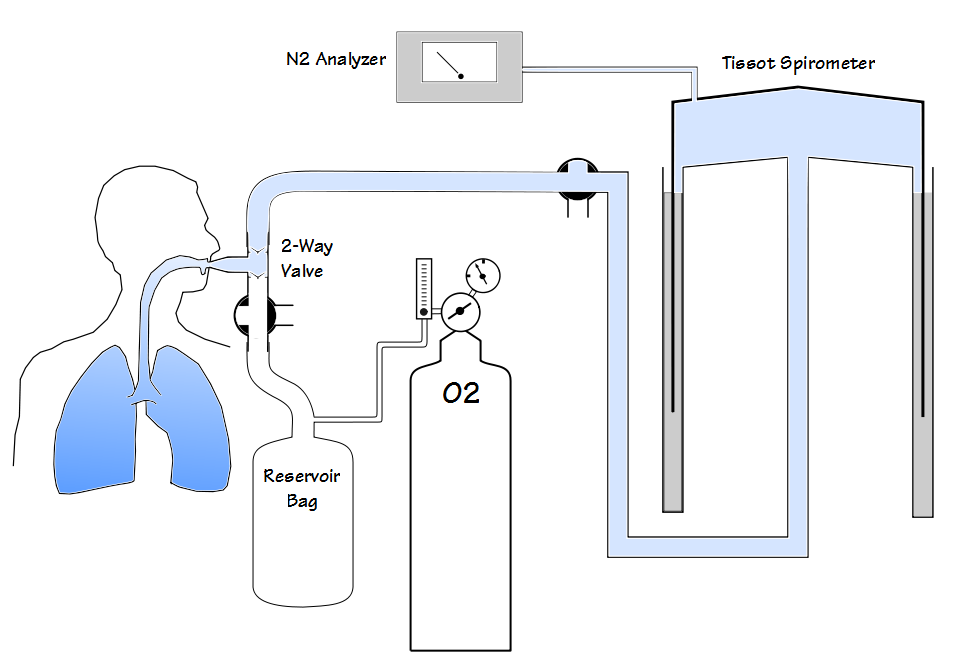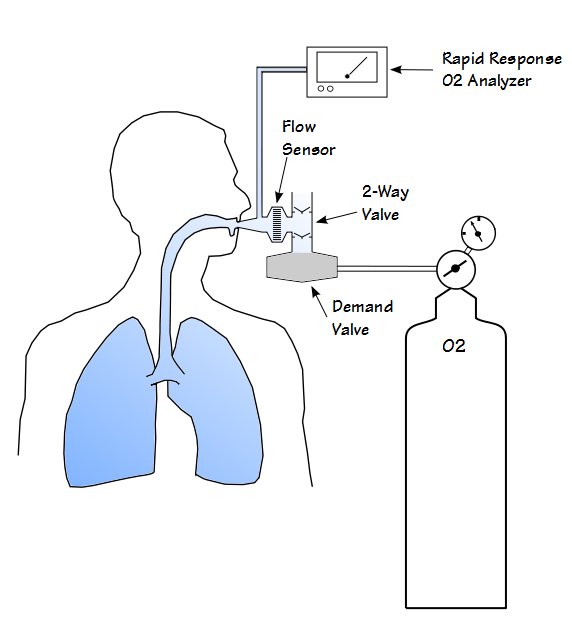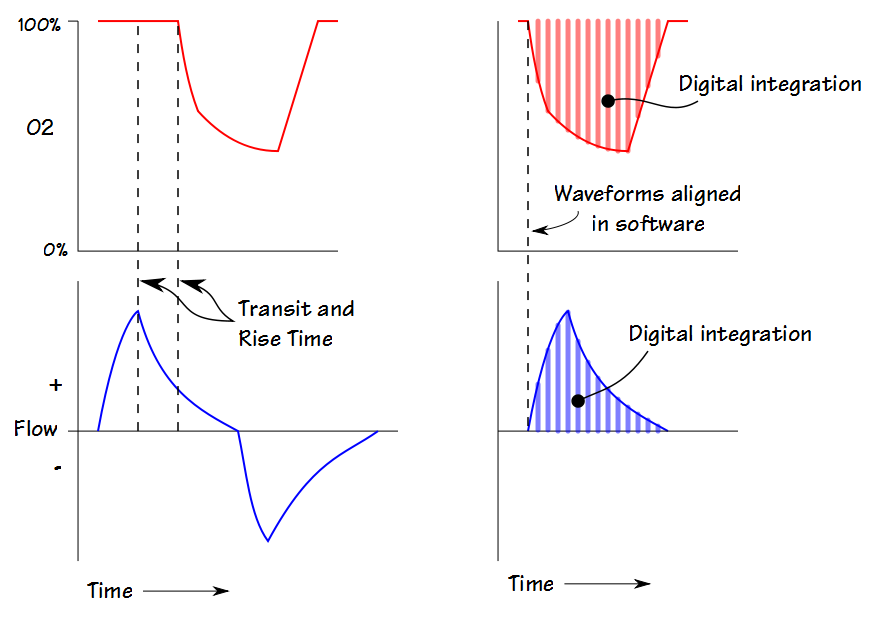I was recently contacted by the manager of a lab that was having problems with their N2 washout lung volumes. Specifically, their N2 washout lung volumes (FRC in particular) were coming out low and everyone being tested on the system looked like they had restriction. The system has been checked by the manufacturer’s service techs several times and they’d replaced the tubing, the O2 tank and a number of parts. Service first asked them to wait between tests and then not to bother. Most lately they’ve been asked to calibrate the system before each test. Despite all this, their system continues to under-estimate lung volumes.
We’ve all had seemingly intractable problems with our test systems at one time or another. Sometimes they’re problems that can only be fixed by replacing major components, such as a gas analyzer or a motherboard. Sometimes they turn out to be something simple that nobody noticed despite looking straight at it numerous times. Experience and good technical support helps, but for every test system there has to be at least a couple of problems that are either uncommon, difficult to diagnose or are happening for the first time. When this happens it’s best to go back to basics and try to see what it is that’s most likely to explain the symptoms.
N2 washout lung volume measurements measure the amount of nitrogen residing in the lung and use this to estimate the volume of the entire lung. Closed circuit lung volume measurements using nitrogen were first attempted in 1932 by Christie. Christie’s approach used a known volume of oxygen to dilute the nitrogen in the lung but accuracy was limited at least in part because the amount of oxygen in the closed circuit was constantly changing due to the subject’s oxygen uptake. In 1940 Darling et al demonstrated an open circuit technique that is the basis for current N2 washout tests. In this approach the nitrogen in a subject’s lung was washed out with 100% O2 and their exhaled air was collected in a Tissot spirometer. After a certain amount of time (nominally 7 minutes) the exhaled volume and the N2 concentration in the Tissot spirometer was measured. The amount of nitrogen that had been exhaled is then calculated using simple math and the subject’s FRC is estimated from that.
Although relatively straightforward, this approach to measuring lung volumes was both time-consuming and cumbersome. Sometime around the 1980’s rapid response O2 analyzers became available and it was realized that everything in exhaled air that wasn’t O2 (or CO2) had to be N2 (or argon). This meant it wasn’t necessary to measure exhaled nitrogen, just exhaled O2. It also meant that N2 washout systems would only need to consist of an O2 source, flow sensor and an O2 analyzer.
Although it greatly simplifies the equipment requirements, this approach requires that the flow and gas analyzer signals be matched and then integrated in order for the volume of N2 washed out with each breath to be accurately measured. An advantage though, is that since the nitrogen concentration (or rather O2 concentration) of each breath is being monitored, it is possible to stop the test when a target N2 concentration is reached, and on my lab’s N2 washout systems this is 2%.
So what are the failure modes for N2 washout?
Like all gas dilution tests, the most common problem is a system leak of some kind. An inspiratory leak will bring in excess nitrogen and a large enough leak will be relatively obvious since it will never be possible to reach the target N2 concentration. A smaller leak however, will only prolong a test and then cause FRC to be overestimated. Since the problem in question is a reduced FRC, not an elevated one, an inpiratory leak (even one involving the patient) is an unlikely culprit.
An expiratory leak on the other hand could cause the system to underestimate the exhaled volume and this would cause FRC to be underestimated. However, for this to happen in a flow-based system, the leak would have to occur before the flow sensor and since an inspiratory leak has been ruled out it would have to be a one-way leak. This isn’t necessarily impossible, but tidal breathing is usually monitored during the N2 washout and an expiratory leak (or an inspiratory leak) would cause noticeable drift.
What if airflow somehow bypassed the flow sensor during both inspiration and expiration? This could cause the expiratory volume to underestimated and if the amount of bypass was equal for both inspiration and expiration the tidal breathing would not drift by much. A problem with this is that one additional clue is that the SVC volume matched the FVC volume so if any expiratory flow is bypassing the flow sensor it has to be a tiny amount. Inspiratory and expiratory flow could also be underestimated due to a calibration error but the fact that SVC matches the FVC, and that both were usually normal, pretty much rules this out as well.
Assuming there’s nothing wrong with the gas analyzer the exhaled N2 could also be underestimated due to a calibration error. Because the N2 concentration is derived from an O2 analyzer, the O2 signal would have to be more biased towards higher values than it should be in order for N2 to be under-estimated. O2 analyzers used for N2 washout are usually calibrated with room air and 100% O2. If the 100% O2 calibration was being contaminated with room air this would cause the O2 concentration to be overestimated (and derived N2 concentration to be underestimated) during the test. Although test systems usually display gas concentrations in some way during the test, this is usually as just the end-exhalation N2 concentration data points and not the entire waveform. Since a symptom of this type of analyzer calibration error would be an O2 concentration above 100% (or derived N2 concentration below 0%) during inhalation this would not necessarily be an obvious problem. One way to determine this was happening would be to inspect the measured gas concentrations while the gas sample line was placed in room air and 100% O2 while disconnected from the testing manifold.
Note: The opposite problem would happen if the room air calibration was being contaminated with O2. If this occurred the O2 concentration would be under-estimated and the derived N2 concentration overestimated.
The gas sample line transit time and O2 analyzer rise time are needed to match the flow and gas analyzer signals and if they are incorrect (and I suspect it doesn’t matter all that much whether they are incorrect in the + or – directions) then the exhaled N2 volume will be underestimated (or under some circumstances possibly overestimated). Transit time and rise time are usually determined by rapidly switching the calibration gas on and off, usually with a solenoid valve or its equivalent. A sticking solenoid valve that was slow to open and close even by a small amount could elevate the measured transit time and this would cause the flow and gas analyzer waveforms to be matched incorrectly. This would be difficult to detect and might only show up by comparing the calibrated transit and rise times over time. Differences of a few 10’s of milliseconds are unlikely to make a significant difference, but differences above 100 or 200 milliseconds could be an indication that transit and rise time are being calibrated incorrectly.
Finally, there could also be leak from the oxygen source used during the N2 washout into the sample line. This would also bias the measured O2 concentrations upwards (and derived N2 concentrations downwards). Conversely, excess room air in the sample line would cause the N2 volume to be overestimated. Whether this could happen at all would depend a lot on the arrangement of the breathing manifold and would be remotely possible in some and impossible in others. This would not be an obvious problem but it would disappear when the manifold was replaced.
To summarize:
FRC Underestimated:
| Possible causes: | Symptoms: |
| Exhalation Leak | SVC ≠ FVC, tidal volume drift |
| Flow sensor mis-calibration | SVC < FVC or SVC & FVC decreased |
| Room air contamination 100% O2 calibration | O2 >100% or N2 <0% during inhalation |
| Incorrect Transit/Rise time | Transit/Rise > 100-200 msec compared to older calibrations |
| O2 leak into sample line | Disappears when manifold is replaced |
FRC Overestimated:
| Possible causes: | Symptoms: |
| Inhalation Leak | SVC ≠ FVC, tidal volume drift |
| Flow sensor mis-calibration | SVC > FVC or SVC & FVC elevated |
| 100% O2 contamination room air calibration | O2 < 100% or N2 > 0% during inhalation |
| Incorrect Transit/Rise time | Transit/Rise > 100-200 msec compared to older calibrations |
| Room air leak into sample line | Disappears when manifold is replaced |
I passed most of these suggestions back to the manager that asked about troubleshooting their N2 washout in a somewhat abbreviated form and have taken the opportunity to expand on them here. I haven’t yet heard back whether any of them are correct and it will interesting to see if one of them is the cause of their FRC measurements error or whether it turns out to be something completely different.
There are other errors that may be very specific to particular testing systems. A general approach however, is to consider what could be causing the N2 volume to either be underestimated or overestimated depending on whether the FRC is routinely coming out low or high. In order to do this, we all need to have a good understanding of the technical aspects of the N2 washout test and the equipment.
Many of these possible errors are not obvious either during an N2 washout test or the calibration of the test equipment. This is why regular biological QC is important and why, if you’re not routinely performing it, you should be.
References:
Christie RV. The lung volume and its subdivisions. I. Methods of measurement. J Clin Invest 1932; 11: 1099-1118.
Darling RC, Cournand A, Richards DW. Studies on the intrapulmonary mixture of gases. III. An open circuit method for measuring residual air. J Clin Invest 1940; 19(4): 609-618.

PFT Blog by Richard Johnston is licensed under a Creative Commons Attribution-NonCommercial 4.0 International License



